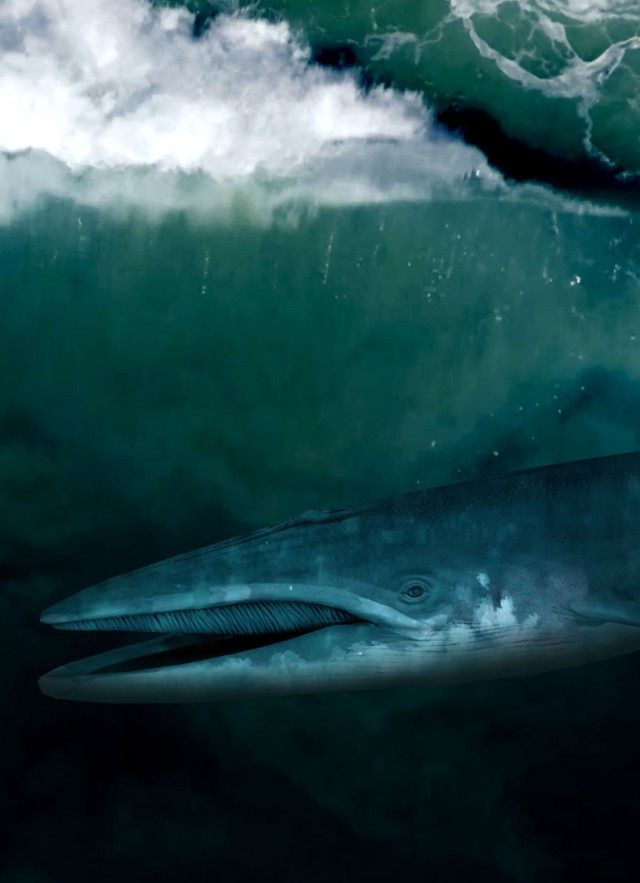Los Angeles, CA (March 29, 2022) –The Natural History Museum of Los Angeles County (NHM) will present L.A. Underwater: The Prehistoric Sea Beneath Us. Opening May 2, 2022, this multimedia-rich immersive exhibition explores the underwater realm of prehistoric Los Angeles when much of the L.A. area was submerged beneath the waves of the Pacific Ocean. Visitors will view rare fossils from across the L.A. region and encounter huge cinematic elements showcasing sharks the size of school buses, glowing deep sea fish, giant tuskless walruses, a 10-million-year-old whale skull discovered in Lincoln Heights, and other awe-inspiring species that roamed ancient L.A. The two-year long exhibition will feature engaging media elements that bring fossils to life and serve as reminders of the ancient ocean that is still shaping L.A. today.
Lori Bettison-Varga, NHMLAC President and Director said, “With L.A. Underwater, we are giving visitors an in-depth look at the Southern California region, millions of years before humans set foot anywhere near Los Angeles. Through NHM’s commitment to discovering the natural world in our own neighborhood and this exhibition's focus on our extensive marine collections, we continue to shape our understanding of the ancient past as well as inform current and future discoveries.” The exhibition features the skull of a newly described giant walrus species, Pontolis barroni, never before seen by the public.
L.A. Underwater guides visitors through Los Angeles’s prehistoric past by showcasing locally discovered fossils that have helped scientists understand the topography of the city. The exhibition features nearly 40 fossils and specimens showcasing the Los Angeles region's vast pre-history, including an ammonoid fossil that dates from nearly 75 million years ago; the 13–15 million year old Coursen's Strange Seal; a 10–50,000 year old saber-toothed cat skull; and a shell discovered in modern L.A. soil.
Many of these fossils were found by everyday Angelenos—from construction workers building the Metro line to discoveries in local neighborhoods by Museum visitors. The exhibition is organized into sections to help tell the story of Los Angeles’s underwater past, beginning with explaining what fossils are and what they can tell us about the past. Another section of the exhibition highlights the many habitats that comprised L.A.’s prehistoric ocean, from sunlit coastal waters to the darkest depths.
A notable specimen is a 10-million-year-old whale skull that was discovered in 1931 by plumber F.W. Maley while digging an irrigation ditch in the Lincoln Heights neighborhood, which is located east of Downtown Los Angeles in one of the city’s oldest neighborhoods. This whale, Mixocetus elysius, was one of the largest baleen whales in the world at the time of its life, with today’s whales being much bigger. The discovery of the skull and new prehistoric species helped scientists understand the evolution of the modern-day whale. Visitors will see it brought to life through a huge immersive wall projection. This section of the exhibition will focus on giant sea life, with some animals like the leatherback sea turtle still swimming near L.A. today.
L.A. Underwater will also address how ancient plankton transformed into the oil beneath L.A., creating a legacy of fossil fuels that has contributed to the city’s overall growth and wealth. Just as scientists use fossils to better understand the landscape of L.A. during different stages of its history, visitors will learn how to analyze specimens and identify clues that tell us stories about L.A.’s past. Using an interactive giant map of L.A., visitors can find fossils near them—and potentially the next great discovery!
Visitors will also be able to review a linear geological timescale demonstrating when L.A. began to emerge from the ocean as it made its way towards its current form, as well as the potential effects of climate change that threaten the city’s future.
L.A. Underwater reflects NHM’s ongoing commitment to marine research and discovery. Recent studies such as the first detection of biofluorescence in a rare deep-sea anglerfish, as well as the recent discovery of a giant ichthyosaur skull, show the museum’s continued interest in sharing discoveries from the underwater world, both past and present, with the community.
Sponsored by Nickelodeon and Los Angeles Department of Water and Power with additional support from Robert Segal.
L.A. Underwater is free with Museum Admission. Learn more at NHM.ORG/underwater.
Through its ongoing partnership with Nickelodeon, NHM will continue exploring the Science of SpongeBob with new content and activities that focus on ancient marine life and the science that inspired the undersea world of Bikini Bottom. Beginning June 7, kids and families from across the country can visit NHM.ORG/spongebob to access DIY activities and a schedule of SpongeBob-inspired virtual programs that Museum Educators will be hosting throughout the month. These kid-friendly Q&As with museum experts will introduce the fossilized ancestors of the show's beloved characters and reinforce that these fossil discoveries are found all across the globe.
About the Natural History Museums of Los Angeles County
The Natural History Museums of Los Angeles County (NHMLAC) include the Natural History Museum in Exposition Park, La Brea Tar Pits in Hancock Park, and the William S. Hart Museum in Newhall. They operate under the collective vision to inspire wonder, discovery, and responsibility for our natural and cultural worlds. The museums hold one of the world’s most extensive and valuable collections of natural and cultural history—more than 35 million objects. Using these collections for groundbreaking scientific and historical research, the museums also incorporate them into on- and offsite nature and culture exploration in L.A. neighborhoods, and a slate of community science programs—creating indoor-outdoor visitor experiences that explore the past, present, and future. Visit NHMLAC.ORG for adventure, education, and entertainment opportunities.
MEDIA CONTACT
For interviews and imagery, please contact Sally Márquez, smarquez@nhm.org.
